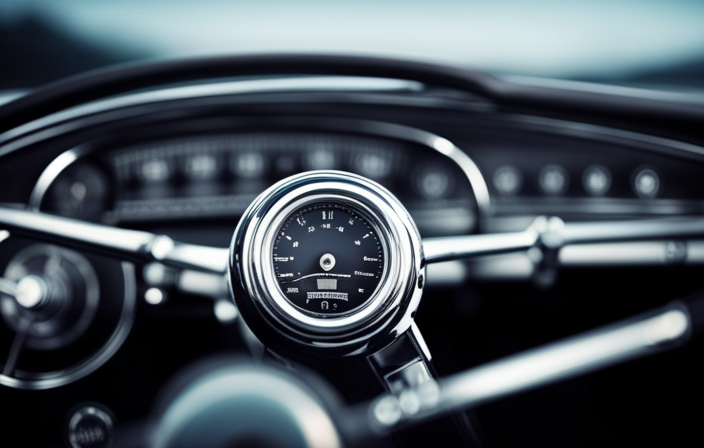Utilizing cruise control on highways can increase fuel efficiency by as much as 7%. This convenient feature offers numerous advantages that enhance the driving experience.
During long highway drives, cruise control allows you to maintain a consistent speed without constantly adjusting the accelerator. This reduces fatigue and ensures a smooth and comfortable journey.
Cruise control is especially useful on monotonous roads, such as endless stretches of straight highway, as it helps combat boredom and keeps your attention focused on the road.
In addition to comfort, cruise control also plays a crucial role in safety. By maintaining a safe distance from other vehicles, it minimizes the risk of speeding accidents and improves overall driving comfort.
However, there are times when you should turn off cruise control, such as heavy traffic or inclement weather conditions.
Join me as we explore the various scenarios where using cruise control is beneficial and learn how to make the most out of this invaluable feature in your car.
Key Takeaways
- Enhancing driving comfort on smooth roads
- Minimizing risk of speeding accidents
- Turning off cruise control in heavy traffic or inclement weather
- Improving visibility in dense fog
Long Highway Drives
When you’re taking those long highway drives, cruise control is your best friend. It not only allows you to maintain a consistent speed, but it also has other benefits that can greatly improve your driving experience.
One of the key advantages of using cruise control on long highway drives is that it helps improve concentration. By freeing up your mind from constantly monitoring and adjusting your speed, you can focus more on the road ahead and potential hazards.
Additionally, cruise control can help reduce stress by eliminating the need for constantly pressing the accelerator pedal. This allows for a more relaxed and comfortable driving experience, especially during extended periods behind the wheel.
With improved concentration and reduced stress, cruise control ensures a safer and smoother journey on those long highway drives. It eliminates abrupt transitions and helps maintain a consistent speed.
Maintaining a Consistent Speed
To maintain a steady pace on the road, it’s helpful to engage the cruise control feature. Not only does it reduce distractions, but it also improves focus by allowing me to concentrate on other important aspects of driving. With cruise control activated, I can keep my eyes on the road ahead instead of constantly adjusting my speed. This helps me stay alert and aware of any potential hazards or sudden changes in traffic conditions. Additionally, using cruise control eliminates the need for constant throttle adjustments, resulting in a smoother and more fuel-efficient drive. By reducing distractions and improving focus, cruise control enhances overall safety on long highway drives.
Transitioning into the next section about reducing fatigue on monotonous roads: Another key benefit of using cruise control is its ability to mitigate fatigue caused by monotonous roads.
Reducing Fatigue on Monotonous Roads
Engaging the helpful feature of maintaining a steady pace on monotonous roads can alleviate the weariness caused by long stretches of repetitive scenery. When using cruise control, it reduces driver fatigue by allowing me to relax and focus on the road ahead instead of constantly adjusting my speed. This feature is especially useful in preventing highway hypnosis, a state of drowsiness or inattentiveness caused by extended periods of driving on uneventful highways.
To further engage the audience, let’s explore two subtopics related to reducing driver fatigue:
-
Automatic Speed Adjustment: Cruise control automatically adjusts my vehicle’s speed to maintain a consistent pace, which eliminates the need for constant pedal adjustments and prevents unnecessary acceleration or deceleration.
-
Audio Alerts: Some advanced cruise control systems include audio alerts that notify drivers if they are drifting out of their lane or approaching another vehicle too closely. These alerts help drivers remain attentive and prevent accidents caused by drowsiness or distraction.
By utilizing these cruise control features, I can reduce driver fatigue and stay alert while driving on monotonous roads.
Transitioning into the subsequent section about saving fuel on flat terrains, it is important to consider how cruise control can also contribute to fuel efficiency.
Saving Fuel on Flat Terrains
By utilizing the steady pace feature on monotonous roads, you can significantly increase fuel efficiency on flat terrains. Cruise control allows for a consistent speed, which optimizes acceleration and reduces unnecessary fuel consumption. When driving on level ground, maintaining a steady speed with cruise control prevents unnecessary fluctuations in engine power output, resulting in improved fuel economy.
Moreover, using cruise control also helps minimize engine wear. Constantly adjusting the throttle to maintain a steady speed can cause additional strain on the engine components over time. By relying on cruise control instead, you reduce the risk of excessive wear and tear on your vehicle’s engine.
Transitioning into improving fuel efficiency on hilly roads, it is essential to adapt cruise control usage based on terrain variations.
Improving Fuel Efficiency on Hilly Roads
Navigating hilly roads is like riding a rollercoaster with the fuel pedal as your conductor. To improve fuel efficiency on such terrains, there are several strategies that can be employed:
-
Modulate Speed: Adjusting the speed while going uphill can help optimize engine performance and reduce emissions. Slowing down before reaching an incline allows the engine to work more efficiently.
-
Utilize Engine Braking: Engaging engine braking on downhill slopes helps save fuel by reducing reliance on traditional brakes. This technique converts the vehicle’s kinetic energy into potential energy, effectively conserving fuel.
-
Plan Ahead: Anticipating steep gradients and adjusting cruise control settings accordingly can enhance fuel efficiency. By maintaining a consistent speed and minimizing unnecessary acceleration or deceleration, less fuel is consumed.
Reducing emissions and optimizing engine performance on hilly roads requires careful attention to driving techniques. By employing these strategies, drivers can make their journey more efficient and environmentally friendly.
Transitioning into the next section about ‘avoiding speeding tickets,’ it’s important to maintain control of your vehicle at all times to ensure both safety and compliance with traffic laws.
Avoiding Speeding Tickets
To avoid getting slapped with a speeding ticket, you’ll want to keep a close eye on your speedometer and make sure you’re within the legal limits. It’s important to remember that cruise control can be a helpful tool in this regard. By setting your desired speed and allowing the system to maintain it, you can avoid unintentionally exceeding the limit.
Additionally, using cruise control can help minimize distractions while driving, as you won’t need to constantly adjust your speed manually. This allows you to focus more on the road ahead and improve your reaction time if any unexpected situations arise. By incorporating cruise control into your driving routine, you can reduce the risk of speeding tickets while also improving overall safety on the road.
Maintaining a safe distance from other vehicles is another crucial aspect of responsible driving.
Maintaining a Safe Distance from Other Vehicles
One important aspect of safe driving is keeping a sufficient distance from the vehicles ahead of you. When using cruise control, it’s crucial to manage distractions effectively to ensure that you maintain this distance.
It’s essential to remain attentive and avoid any activities that may divert your attention away from the road.
Additionally, adjusting the cruise control settings for different road conditions plays a significant role in maintaining a safe distance. For example, on slippery roads or during heavy traffic, reducing the speed setting can allow for better control and reaction time. By doing so, you can minimize the risk of collision with other vehicles.
Now, let’s explore how enhancing driving comfort on smooth roads further improves your overall experience without compromising safety.
Enhancing Driving Comfort on Smooth Roads
Maximize your driving pleasure on smooth roads by making small adjustments to your speed and enjoying the blissful sensation of gliding effortlessly.
To enhance overall driving experience and increase relaxation while driving, consider the following:
- Fine-tune your cruise control settings to match the road conditions, allowing for a smoother ride.
- Utilize cruise control’s ability to maintain a constant speed, reducing the need for constant acceleration and deceleration.
- Take advantage of cruise control’s ability to reduce driver fatigue by eliminating the need to constantly monitor and adjust speed.
- Enjoy a more comfortable driving experience with cruise control’s ability to provide a consistent throttle response.
- Reduce distractions on smooth roads by setting your desired speed using cruise control.
By incorporating these techniques, you can enhance your comfort and relaxation while driving.
Transitioning into minimizing the risk of speeding accidents, it is important to understand how cruise control can be effectively utilized in various road conditions.
Minimizing the Risk of Speeding Accidents
Reduce your risk of speeding accidents by implementing safe driving practices and being mindful of the speed limits on various road conditions. By reducing speeding risks, you can effectively prevent accidents and ensure a safer driving experience.
One way to achieve this is by using cruise control responsibly. While cruise control can help maintain a consistent speed, it is important to remember that it does not replace the need for vigilance and awareness on the road. Always adjust your speed according to traffic conditions and adhere to posted speed limits.
Additionally, be cautious when using cruise control on hilly or curvy roads, as it may cause the vehicle to lose traction or increase the risk of skidding.
Turning off cruise control in heavy traffic or inclement weather is crucial to prioritize safety above all else.
Turning off Cruise Control in Heavy Traffic or Inclement Weather
When heavy traffic or inclement weather strikes, it’s time to hit the brakes and let go of that automated speed regulator. Turning off cruise control in heavy rain and dense fog is crucial for maintaining safety on the road. These weather conditions can greatly reduce visibility, making it difficult for the system to accurately detect obstacles or adjust speed accordingly.
In heavy rain, water on the road can cause hydroplaning, leading to loss of control. By turning off cruise control, I’m able to have better control over my vehicle’s acceleration and braking.
Dense fog reduces visibility to a dangerous level. Without clear sightlines, relying on cruise control may prevent timely reaction to sudden changes in road conditions or hazards.
Additionally, turning off cruise control allows me to maintain a consistent speed suitable for the current driving environment.
In conclusion, when faced with heavy rain or dense fog, it is essential to deactivate cruise control and rely on manual operation for increased safety and adaptability.
Frequently Asked Questions
Can I use cruise control on city streets or in heavy traffic?
No, it is not advisable to use cruise control on city streets or in heavy traffic. Cruise control is best utilized on long road trips and highways due to its benefits of maintaining a constant speed and reducing driver fatigue.
Does using cruise control affect the performance of my vehicle’s brakes?
Yes, using cruise control can affect brake wear and fuel efficiency. When engaged, the system maintains a constant speed by applying the brakes when necessary. This can result in increased brake wear compared to manual driving. Additionally, constant speed control can lead to improved fuel efficiency.
Is it safe to use cruise control in rainy or snowy conditions?
Using cruise control in rainy or snowy conditions can be dangerous. It may cause loss of traction and make it harder to control the vehicle. Additionally, it could impact fuel efficiency negatively due to increased resistance from the weather conditions.
Will using cruise control improve the lifespan of my tires?
Using cruise control will not improve the lifespan of your tires. However, it can improve fuel efficiency and reduce driver fatigue by maintaining a consistent speed on long trips.
Can cruise control be used with manual transmission vehicles?
Yes, cruise control can be used with manual transmission vehicles. It offers several benefits such as relieving driver fatigue on long trips and maintaining a consistent speed, resulting in better fuel efficiency and reduced wear on the engine.
Conclusion
In conclusion, cruise control is a valuable tool for long highway drives when maintaining a consistent speed is crucial. It helps reduce fatigue on monotonous roads and saves fuel on flat terrains, improving overall efficiency. Additionally, it ensures a safe distance from other vehicles and enhances driving comfort on smooth roads.
However, it should be turned off in heavy traffic or inclement weather to maintain control of the vehicle. Like a guiding star in the night sky, cruise control navigates us through the vast highways with precision and ease.










